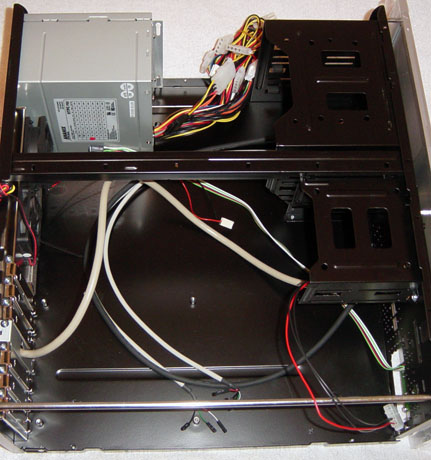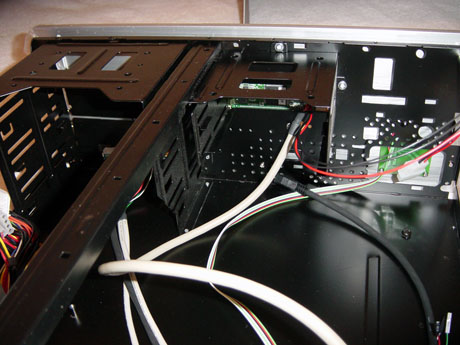A First Look at the HTPC Case Genre with the Ahanix D.Vine 4
by Purav Sanghani on October 10, 2004 1:00 PM EST- Posted in
- Cases/Cooling/PSUs
Internal Design
Comparing mid-tower cases to HTPC cases is like comparing apples to oranges, which is why we have started a fresh new board to compare the various HTPC cases out there. To understand better the layout of an HTPC case, we needed to first become familiar with the design of a single home theater component.We notice that each component in a home audio/video setup is a single unit, which is about 17" in width and can range in depth from 6"-17" depending on the component. This helps keep a consistent look when lining each unit up on a shelf and gives the entire display an organized look.
In order for this to be the case for an HTPC chassis, the motherboard and drive bays as well as the power supply would all need to be mounted both to utilize space efficiently as well as in a technologically feasible manner for that particular component.
Looking at the insides of the D.Vine 4, we see that the motherboard is, of course, laid to rest at the bottom of the case. The power supply would be mounted at the back right of the chassis, which is where it would normally be on a mid-tower case when standing upright.
The drive bays are all at the front of the chassis, but are limited to two to three 5-1/4" drive bays and two to three 3-1/2" drive bays, which are organized horizontally to utilize space efficiently as well as positioning components to operate to manufacturer specifications. Ahanix has implemented a three 5-1/4" bay design while limiting hard drive mounts to two bays. This should be ample in an HTPC setup, since they can be networked to, say, a media server or other PCs around the area, but the D.Vine 4 could have been expanded to four 3-1/2" bays to utilize the remaining space better.<












21 Comments
View All Comments
jeffyjones - Monday, October 11, 2004 - link
I have the D5 case, and I love how it looks. The display is kind of useless, and I hate the cheap punch-out slot covers, but it looks fabulous from the front.PuravSanghani - Monday, October 11, 2004 - link
#9: This article was actually meant to be an introduction to the HTPC case genre, as the title states, and not really a full blown review. We chose the D.Vine 4 because, well, we needed to start somewhere and rest assured, we will have newer HTPC cases to review in the future!pmark - Monday, October 11, 2004 - link
Why did you choose to review this one when it seems that Ahanix has newer verisons of the case out?maxdido - Monday, October 11, 2004 - link
perhaps a stupid question but i'm new to htpc.how do you control this thing. is there a remote?
or do you have to buy one?
tis66 - Monday, October 11, 2004 - link
Just a suggestion:it'd be nice 2 include some pictures to see the actual cabling, speakers setup, and how the HTPC fit in with other AV equipments in a living room, just to give a clearer view of its usefulness.
zagaroth - Sunday, October 10, 2004 - link
I still think the way to go for a really nice look is to get something along the lines of http://www.mini-itx.com/store/default.asp?c=3 for a nice slimline case and then use MythTV. (i like the 'Travla C137 Mini-ITX Case - Black' It fits right in with my stuff.) Having a quite (or in some case's fanless) case with NO harddrive and a quite dvd drive beside the TV. Have it boot over the network from a grunty machine with 2-4 TV tuner cards in it in the basement where it can be as loud as you want makes for a nice setup. The only cables that end up going into it is a network cable a power cable and then the svideo-out and coax-digital audio out. I've found my EPIA-M10000 can be made passavely cooled and is gruntly enough to do want i want. Though if you were to buy one now you can get one of the MII or something which provide alot more power...PuravSanghani - Sunday, October 10, 2004 - link
ksherman: We didn't mean to sound like we were knocking it or anything. It is a well constructed case and this article was basically a starting point in our expansion towards a wider range of cases. As we look at more HTPC cases we will begin to see trends in results much like those in mid tower cases. But comparing cooling to mid tower cases should not be an issue as almost all of the medium sized mid tower cases match the size of Ahanix's HTPC chassis.TO summarize what we learned in HTPC cases there is a trade off between thermal and sound results; a cooler running system with larger or more fans, or a quieter system with the smaller, less powerful fans.
ksherman - Sunday, October 10, 2004 - link
I think it rocks! Though I dont see why it was nocked on because it was about 5-6 degrees hotter than a good mid-tower case... It is really not that big of a difference, and at leasts its quiet.Koing - Sunday, October 10, 2004 - link
Ditto with Octunar99.When you spend upwards of £250 on a dam hifi stand you don't mind spending £200 on a pc case for your hifi rack.
If you have invested quite a bit of money in to your kit you don't mind spending money on this.
It looks nice.
Koing
Octunar99 - Sunday, October 10, 2004 - link
I think the point is that no self respecting audiophile would have a regular PC in his/her audio rack or next to his/her TV/Home Theater.This really give you the ability to integrate a PC in your audio rack and have it look like it supposed to be there.
Two thumbs up! I would like to a slim version however. My next audio rack will feature slim components to balance with my Plasma.